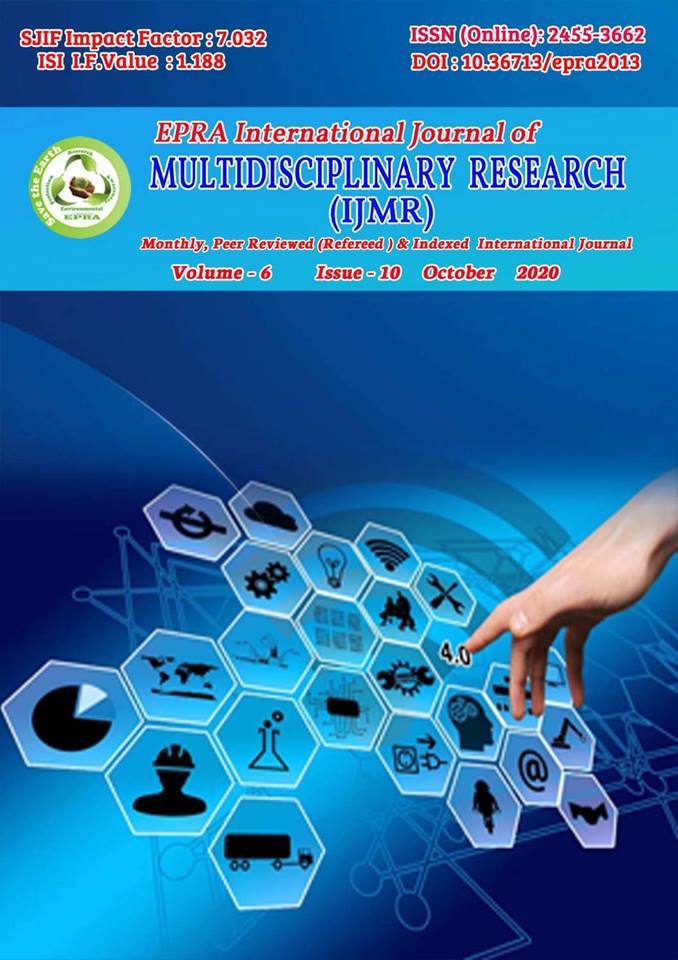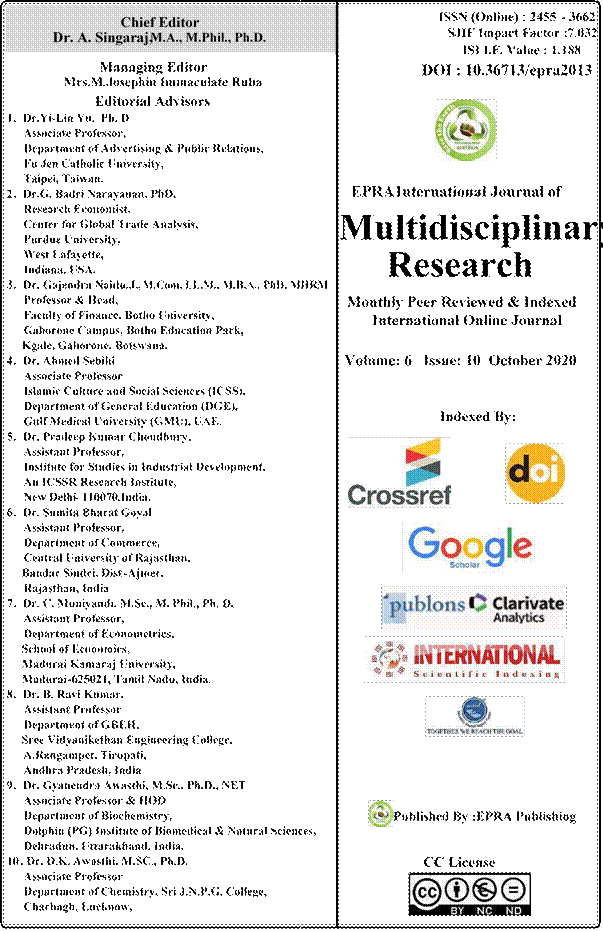


METHODS OF WORKING WITH TEXT IN LITERARY
READING LESSONS IN ELEMENTARY SCHOOL
Ismatov Sobirjon Raximqulovich
Bukhara State University,
Bukhara, Uzbekistan
![]()
ABSTRACT
This article discusses the issue of organizing work with texts in literary reading lessons using effective technologies.
KEYWORDS: text, student, reading, analysis, techniques, assimilation, search, presentation, efficiency, inference, book, experience, material, volume, information.
![]()
By teaching my students, I only create the conditions in which they themselves learn. "A modern lesson is a lesson in which the maximum of a child and a minimum of a teacher, a lesson in which children work more, and the teacher only directs their work.
My experience suggests that a student assimilates 10% of what he hears, 50% of what he sees, 70% of what he says, and 90-100% of what he does himself. Therefore, for myself, I highlighted several aspects of a modern lesson: the interaction of students with each other, a teacher-coordinator of acquiring knowledge; a lesson in which each student learns with interest; a lesson that should be based not on obedience, imitation and repetition, but on an independent search for truth, on the analysis and synthesis of different points of view, own observations and experiments; a lesson that should be focused on the development of the creative abilities of students, on the use of modern technologies. Techniques for working with text in the lesson for different types of reading ( viewing , introductory and studying )
Information technologies and their methods of presenting educational material have changed dramatically. The book and printed text are the main teaching aids, but a modern lesson implies new approaches to work.
At least for the minimum time allotted in the lesson to achieve the effectiveness of reading, and turn the lesson into an exciting interesting study? Most teachers in their lessons are faced with the fact that students do not know how to work with the text.
Possible reasons: modern children in conditions of oversaturation of the information environment read little educational and additional literature, textbooks contain a fairly large amount of material, the educational process is aimed at independent acquisition of knowledge.
Working with text is one of the main tasks in any lesson. It is not enough to simply ask students to open the book on the right page, read the material and answer the question. This will lead to the lack of the required result and a senseless waste of time in the lesson.
The same type of activity within a lesson can be structured in different ways so that it becomes not only productive, but interesting and motivating for students. For reading to be productive, students must take an active position, carrying out a variety of mental operations. When working on a text, it is important to take into account the types of reading that have different goals.
Types of reading:
View reading is the most superficial kind, giving the most general idea of the content and meaning of the text. The end result is a decision whether to read the text or not.
Techniques for working with text , used for viewing reading:
1. Analyze the subheading as well as predict the topic of the text.
2. Analyze subheadings if they are present in the text.
3. As an additional task, you can view drawings and times highlighted highlights in the text.
4. Get acquainted with the structure of the text.
5. View the first as well as the last paragraph of the readable text. Acquaintance with the table of contents.
6. Use text annotations.
I begin the study of a new text by reading the author's surname, the children give a summary of his work, then we read the title, consider the illustrations.
We express our assumptions about the theme of the work, about the characters, content, development and actions. The children read the key words, which are isolated from the text in advance and are written by me on the board, I set the children the task of checking and clarifying their initial assumptions .
An introductory reading is more detailed than a viewing. This type is characterized by the extraction of basic, but not additional information from the text being read. As a result, students determine if there is enough information in the text or if it needs to be re-read or analyzed. Techniques for working with text , used for trial read:
1. Students read the text paragraph by paragraph.
2. It is important to focus on the nouns, the first and last sentences of each individual paragraph.
3. Highlighting important information.
4. You can determine the main thing while reading the text.
5. Arrangement of graphic signs adopted by the students themselves:? - I do not understand or! - it is interesting.
I'm working with text, use annotated reading. The commentary should be short and dynamic. During reading, children mark incomprehensible words. After reading these words, they are discussed: is it possible to understand the word from the context or is the help of an explanatory dictionary needed.
Study reading is the most detailed type of reading.
The purpose of this type is not just a thorough study, but also penetration into the meaning of the text, a detailed analysis of the text. The end result is aimed at understanding all levels of the text, as well as the perception of various information presented in the text (factual, conceptual and subtext). Reading goals are achieved using a variety of techniques for each type of reading.
Techniques for working with text , used for studying reading
1. Highlighting the semantic parts of the read text.
2. Predicting the content and meaning of subsequent parts of the text, based on what you read.
3. Highlighting keywords of the text as you read.
4. Replacing the semantic parts of the text with their equivalents.
5. Revealing details as well as subtextual information contained in text.
6. Determination of the belonging of the text to a specific functional style. Drawing up questions that are problematic, both during and after reading the text.
7. Making judgments of students.
8. Drawing up a plan or graphical diagram that will help to identify the structure of the text, as well as the relationship of its individual parts. Students love that what kind of task.
9. Recycling the text, creating new texts based on the read. Writing a commentary is the final stage of work on the text for a student reading.
The listed methods of working with text are basic, but far from the only ones. Their use is largely determined by the teacher himself, his desire to work creatively and look for new effective ways to solve problems in the classroom. The choice of certain techniques also depends on the level of preparedness of students and their learning motivation.
I believe that in order to work with text to become productive, it is necessary: to carefully build the lesson's algorithm, think over its course to the smallest detail, clearly set tasks for students, focus on the level of students' preparedness and their educational motivation; do not forget about a differentiated and personality-oriented approach.
![]() These
techniques are also effective in that they help the student to design the
educational process, track the directions of his development, and determine the
final result himself.
These
techniques are also effective in that they help the student to design the
educational process, track the directions of his development, and determine the
final result himself.
It becomes obvious that the use of even some techniques makes it possible to activate the thinking activity of students. Techniques help the teacher replace passive listening and retelling with active participation of students in the educational process, and thereby increase the effectiveness of teaching. "The learning outcome is not assessed by the amount of information provided, but by the quality of assimilation and development of
learning and self-education abilities."
1. Alijon R Khamraev. Modeling Teacher's Activity in Designing Students’ Creative Activities. Eastern European Scientific Journal.2019/5/10/
2. O‘qish kitobi: 1-sinf uchun darslik / Mualliftuzuvchilar:T. G‘afforova, E.Shodmonov, G. Eshturdiyeva; Mas’ul muharrir: S. Mat chonov. — T.: «Sharq» 2017. — 128 b.
3. O‘qish kitobi 4-sinf: umumiy o‘rta ta’lim maktablarining 4-sinfi uchun darslik/S. Matchonov [va boshq.]. - Qayta ishlangan va to‘ldirilgan oltinchi nashr.- Toshkent.:
«Yangiyo‘l poligraf servis», 2017. - 216 b.
4. Avezmurodovich, O. R. (2020). Difficulties in learning to write and read left-handed children. European Journal of Research and Reflection in Educational Sciences, 8 (8), 40-45.
5. Rustambek QO’LDOSHEV. Chapaqay bolalarni maktabga qanday tayyorlash kerak? Pedagogik mahorat. Ilmiy-nazariy va metodik jurnal Buxoro 2020-yil, 3-son 145-147 b.
6. Azimov Y., Hamroyev A. Husnixat va uni oqitish usuliyoti (Ma`ruza matnlari). Buxoro, 2003, -52 bet.
7. R.A.Qo`ldoshev. Кӯмаки педагогӣ ба кӯдакони чапдаст дар соли якуми хониш.-GlobeEdit, 2020.-93 bet
8. Y.Y.Azimov, R.A.Qo’ldoshev. Husnixatga o’rgatishning amaliy asoslari (metodik qo`llanma). GlobeEdit, 2020. - 141 bet.
Материалы на данной страницы взяты из открытых источников либо размещены пользователем в соответствии с договором-офертой сайта. Вы можете сообщить о нарушении.